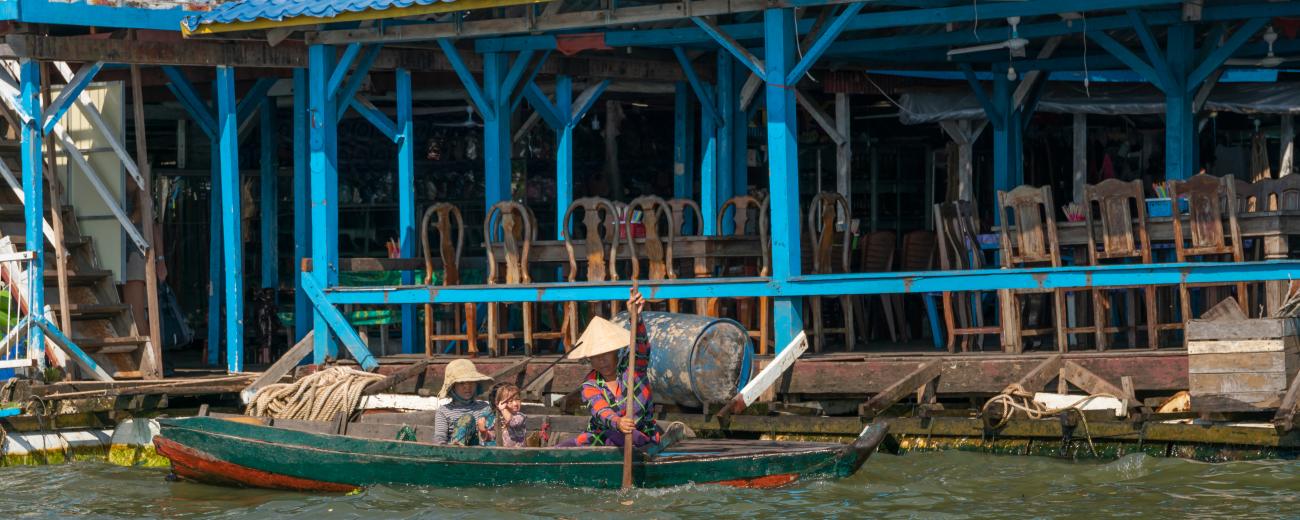Permanent Impermanence: Thousands of Vietnamese families excluded from Cambodian society


In July 2021, Bach Bai was forced from his home in Cambodia’s capital Phnom Penh. He was one of the hundreds of individuals expelled from their homes in the latest wave of evictions in ethnically Vietnamese enclaves.
Although Bai and his family were born and raised in Cambodia, the Royal Government of Cambodia (RGC) does not recognise them as citizens or immigrants. Instead, the RGC refers to its ethnic Vietnamese inhabitants – the largest minority group in Cambodia – as “nonimmigrant foreigners.” As a result, around 90% of ethnically Vietnamese people in Cambodia are not allowed to buy property, get jobs in factories, attend public schools, open bank accounts, own land or property, or even receive a birth certificate.
The treatment of “nonimmigrant foreigners” embodies commonplace anti-Vietnamese sentiments in nearly every stratum of Cambodian society. From the ruling party to otherwise liberal NGOs and political parties, ethnically Vietnamese people in Cambodia are under near-constant threat of state-sanctioned violence.
This position situates itself within a broader discussion of how imagined borderlands make worlds. An analysis of borderlands in the Cambodian context elucidates the lines of inclusion and exclusion, the social ordering of people and places by creating difference and designating people as “other,” and the governmental responses to these conditions.
Modern Anti-Vietnamese sentiment in Cambodia
Anti-Vietnamese beliefs in Cambodia are a longstanding, intricate, and serpentine element embedded in the fabric of the country. Even if its roots and repercussions are not logical or justifiable, they are comprehensible. Cambodian-Vietnamese relations have been tense for centuries, resulting in jingoistic discrimination on both ends. Relations became particularly strained during the 17th-19th centuries when Vietnam repeatedly invaded and arrogated land from Cambodia. Consequently, Cambodians remain wary of any Vietnamese presence in the country. In large part, anti-Vietnamese attitudes result from a belief that Vietnam is still attempting to colonise Cambodia.
The contemporary manifestations of ethnic discrimination by Cambodians against Vietnamese people most directly find their origins in the Cambodian-Vietnamese war of 1978-1989.
In 1978, Vietnam sent troops into Cambodia with the mission of toppling the regime of Pol Pot and the Khmer Rouge. By and large, the survivors of the Khmer Rouge’s reign initially considered the troops as liberators, but as time ticked on, Vietnamese forces appeared more and more like occupiers.
Soon, they were seen as invaders, launching a decade-long war between Cambodian guerillas and the Vietnamese military. The next ten years were characterised by bloodshed and a complex reshaping of Vietnamese hegemony in Cambodia.
Justifying their occupation as an attempt to recover from war and stave off any attempts by the Khmer Rouge to regain power, the Vietnamese army took part in human rights abuses and widespread deforestation.
After years of civil war in Cambodia, the characteristics of the Vietnamese government’s intervention seemingly reinforced already rampant anti-Vietnamese attitudes in Cambodia. Even in their most exaggerated forms, anti-Vietnamese sentiments in Cambodia are predominantly an undue reaction to the actions of Vietnamese elites.
Today, however, we see these postures directed not at the Vietnamese government but at one of the most vulnerable segments of Cambodian society: Vietnamese “nonimmigrant foreigners.”
Spatial Incarceration
Ethnically Vietnamese people’s status as “foreigners” puts them at a nexus of international and domestic discrepancies. Situated not only in the colonial history of Southeast Asia but also in the unfolding of Cambodian-Vietnamese relations, ethnically Vietnamese residents are simultaneously suppressed and subjugated by the Cambodian government and disregarded by the Vietnamese government. The Cambodian government views them as Vietnamese, and the Vietnamese government views them as Cambodian. Their blurred identities are ignored, replaced with a binary view of a complex identity. As a consequence of this binary view, ethnically Vietnamese people are in a position that bears a resemblance to what Deirdre Guthrie describes as a “borderland.”
For Guthrie, a borderland refers to “spaces on the frontiers of adjoining categories (identities, countries, etc.) where rigid differences sometimes blur.” This is evidenced in the fishing villages of Tonlé Sap, where rural pluralism is the norm.
Despite the inflammatory rhetoric of the Cambodian government, both Khmer and ethnic minorities in these settlements peacefully coexist. In fact, a significant number of people in settlements like Chong Koh, those who are considered Vietnamese, are children of mixed Khmer and Vietnamese marriages. Moreover, thousands of the residents of fishing settlements feel Cambodia is their home, as most have lived in Cambodia for their entire lives. These factors come together to complicate the identity forced upon ethnically Vietnamese people by popular rhetoric.
A central contradiction posed by the treatment of ethnically Vietnamese people is found, in some form, across all neoliberal capitalist economies. Just like countries around the world, the wealth of Cambodian elites are both dependent on and threatened by the insecure definition of identity rooted in conceptions of borders.
It follows then that ethnically Vietnamese people’s vital underpinning of the Cambodian economy and the RGC’s postulation that it can fully control its territory stand in direct contradiction.
Moving Forward
Ethnically Vietnamese people living in Cambodia find themselves in a cumbersome and unequal web of contradictions. Their identities, both in form and practice, deviate from the traditional, binary view of borders. They are both included and excluded from segments of Cambodian society. Designated as “nonimmigrant foreigners,” they are categorized as the “other” and placed at the bottom of the economic wrung.
Rendered stateless by the Cambodian and Vietnamese governments, a theoretical view of people living as “nonimmigrant foreigners” is not enough. Instead, we must take a pragmatic look at the material conditions of ethnic minorities in Cambodia, amplifying their concerns and promoting their solutions.
About the Author
Graham Nilles is a SOAS student, completing his MSc in Migration, Mobility, and Development. Focusing on migration and disability, he has worked with non-profit organizations in the United States, Central America, and South East Asia.